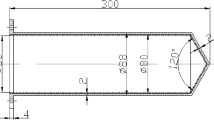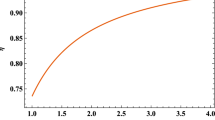Abstract
This paper presents the overall design for large (\(\sim \)400 mm aperture) reference blackbody cavities currently under development at the Science and Technology Facilities Council Rutherford Appleton Laboratory Space Department (STFC RAL Space), in collaboration with the National Physical Laboratory (NPL). These blackbodies are designed to operate in vacuum over a temperature range from 160 K to 370 K, with an additional capability to operate at \(\sim \)100 K as a point of near-zero radiance. This is a challenging problem for a single blackbody. The novel thermal design presented in this paper enables one target that can physically achieve and operate successfully at both thermal extremes, whilst also meeting stringent temperature gradient requirements. The overall blackbody design is based upon a helium gas-gap heat switch and modified to allow for variable thermal conductance. The blackbody design consists of three main concentric cylinder components—an inner cavity (aluminium alloy), a radiation shield (aluminium) and an outer liquid nitrogen (\(\hbox {LN}_{2}\)) jacket (stainless steel). The internal surface of the cavity is the effective radiating surface. There is a helium gas interspace surrounding the radiation shield and enclosed by the \(\hbox {LN}_{2}\) jacket and the inner cavity. The blackbodies are now at a mature stage of development. In this paper, the overall design, focusing upon the thermal design solution, is detailed. This paper will also concern the full-scale prototype breadboard model, for which results on thermal stability, spatial gradients and other sensitivities will be presented.









Similar content being viewed by others
Notes
The minimum achievable helium pressure within the blackbody will be \(10^{-4}\) mbar. At this pressure, there is insignificant gas conduction or convection. This is therefore effectively 0 bar.
References
ESA Media Relations, Beyond MSG and MetOp. (ESA, 2012), http://www.esa.int/Our_Activities/Observing_the_Earth/Meteosat_Second_Generation/Beyond_MSG_and_MetOp. Accessed 16 June 2016
A. Lucianetti et al., OSA 19, 12766–12780 (2011)
D. Peters, Radiometric Calibration of the High Resolution Dynamics Limb Sounder, D. Phil thesis, University of Oxford (2004)
D. Gilmore, Spacecraft Thermal Control Handbook, vol. 1, 2nd edn. (The Aerospace Press, El Segundo, 2002)
J.J. Barnett, et al. (2003). doi:10.1117/12.507496
Acknowledgements
This work was done under contract to Thales Alenia Space—France (TAS-F) and Otto Hydraulik Bremen (OHB) under European Space Agency (ESA) contract AO10178 / ITT 42.3 & 80.3 MTG Phase B2,C,D—for OGSE batch 3 in two lots, lot 1 for Flexible Combined Imager (FCI), and lot 2 for Infra Red Sounder (IRS).
Author information
Authors and Affiliations
Corresponding author
Additional information
Selected Papers of the 13th International Symposium on Temperature, Humidity, Moisture and Thermal Measurements in Industry and Science.
Rights and permissions
About this article
Cite this article
Melzack, N., Jones, E., Peters, D.M. et al. Variable Temperature Blackbodies via Variable Conductance: Thermal Design, Modelling and Testing. Int J Thermophys 38, 30 (2017). https://doi.org/10.1007/s10765-016-2167-5
Received:
Accepted:
Published:
DOI: https://doi.org/10.1007/s10765-016-2167-5




